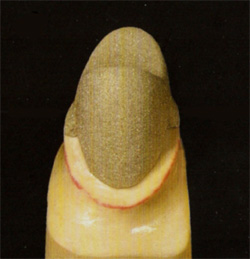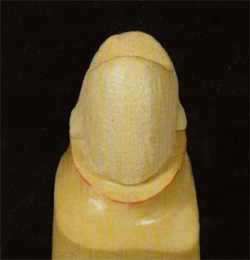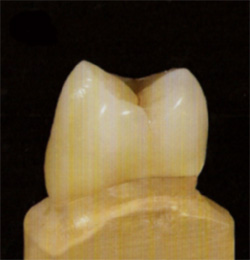porcelain fused to metal bridges
 Metal ceramic (porcelain) fixed prostheses correspond to present days requirements. A thin metal cup surround the prepared tooth stump, and it is fused at high temperature ceramic materials. This metalceramic dental prosthesis is possible to use different colors (the neck of the natural tooth is darker, and incisal parts are transparent). The metal ceramic technology advantage is that the whole restoration can be tooth-colored, the mechanical stability, the ceramic surface is smooth, solid and it is not prone to discoloration, less plaque is deposited on it.
Metal ceramic (porcelain) fixed prostheses correspond to present days requirements. A thin metal cup surround the prepared tooth stump, and it is fused at high temperature ceramic materials. This metalceramic dental prosthesis is possible to use different colors (the neck of the natural tooth is darker, and incisal parts are transparent). The metal ceramic technology advantage is that the whole restoration can be tooth-colored, the mechanical stability, the ceramic surface is smooth, solid and it is not prone to discoloration, less plaque is deposited on it.
Further progress is in the development of metal ceramic restorations the preparation of a shoulder shape at the edge of the crown, so that theres no step at the encounter of tooth and ceramic crown, so it is more hygenicand less prone to gingivitis. Second, there is a possibility of a ceramic shoulder design at the visible parts of gingival edge, which prevents the gray discoloration of gum due to metal.
 |
 |
The dental technician prepares casting the metal framework, which surround the tooth stump like a cap. |
The color of the metal is covered by a thin unglazed layer |
 |
 |
Finally, the design of the tooth fused by ceramic layer by layer. |
The tooth-colored restoration. The cervical part is darker colored, the incisal area is experiencing translucent |
Once the impression arrived in the dental lab, dental technician prepares the plaster cast. Then using wax, the shape of the metal framework is modelled. The waxmodel is surrounded by investment material, and it will be burned out at high temperature, so a negative sample is produced. This negative model is injected in the molten metal (investment-cast). After the cooling the metal framework is finished. The color of the metal is covered by a thin unglazed layer, and using different colors the crown is prepared layer by layer. The high temperature fusing process develops the color of the teeth and the surface becomes shiny.
Therefore, the metal ceramic technology can reproduce the color of the teeth. However, in order to be perfect for a prosthesis, it should be also transparent. First dental lab step the metal framework should be covered so the natural transparency (transparency, light transmission) will be lost. An obvious solution is leaving the metal framework, or substitution of non-metallic material, but it can not come at the expense of the mechanical stability of the prosthesis. In recent years, thanks to developments the proper technology has found to prepair metal-free restorations.


